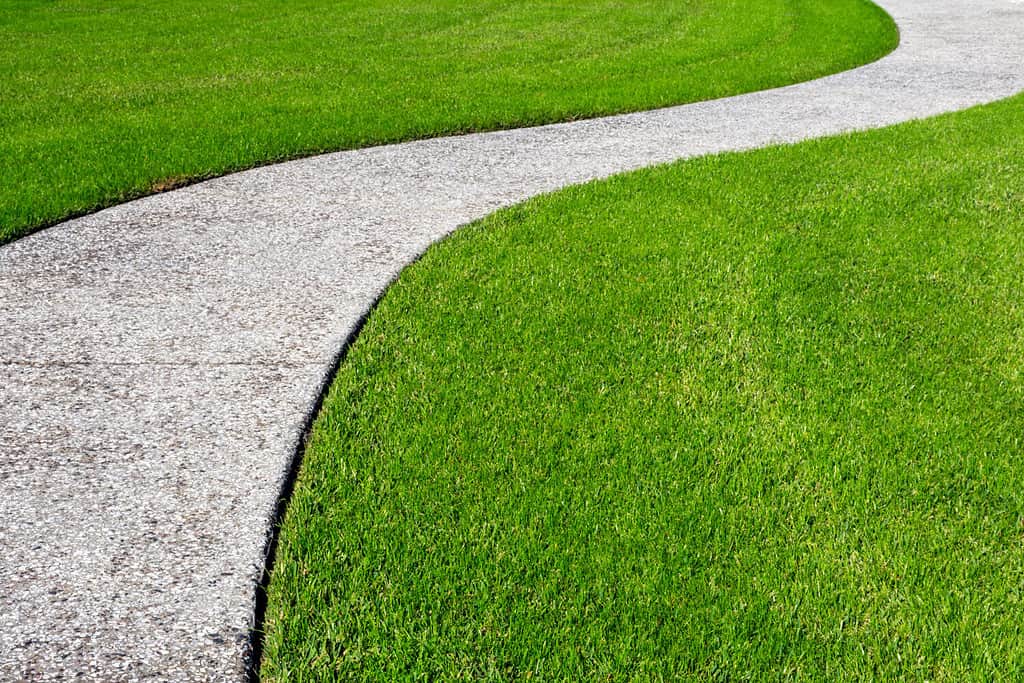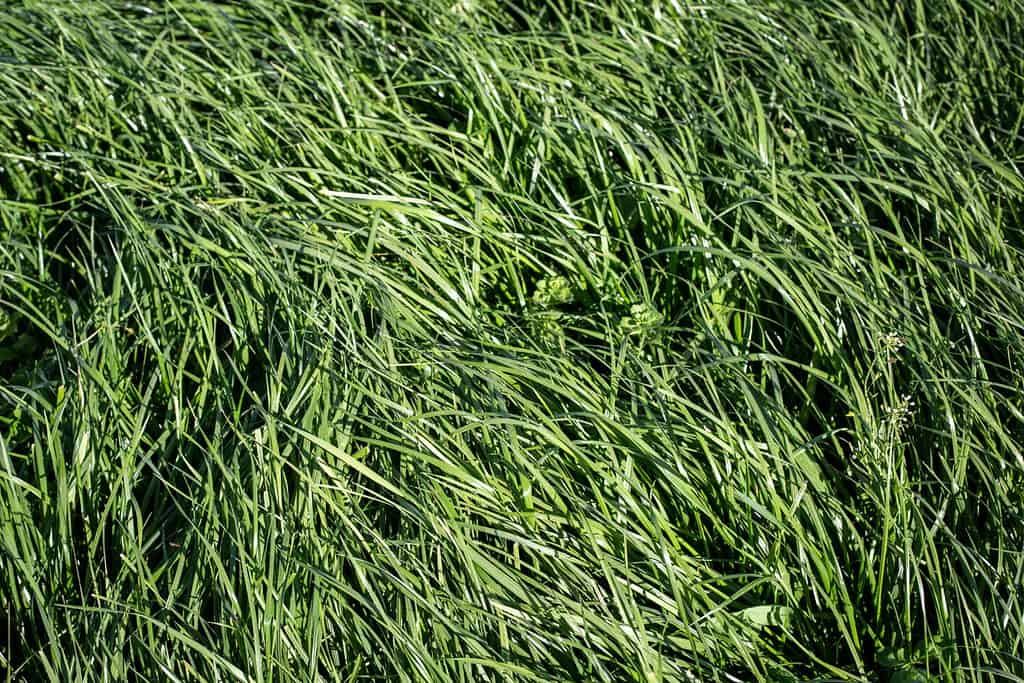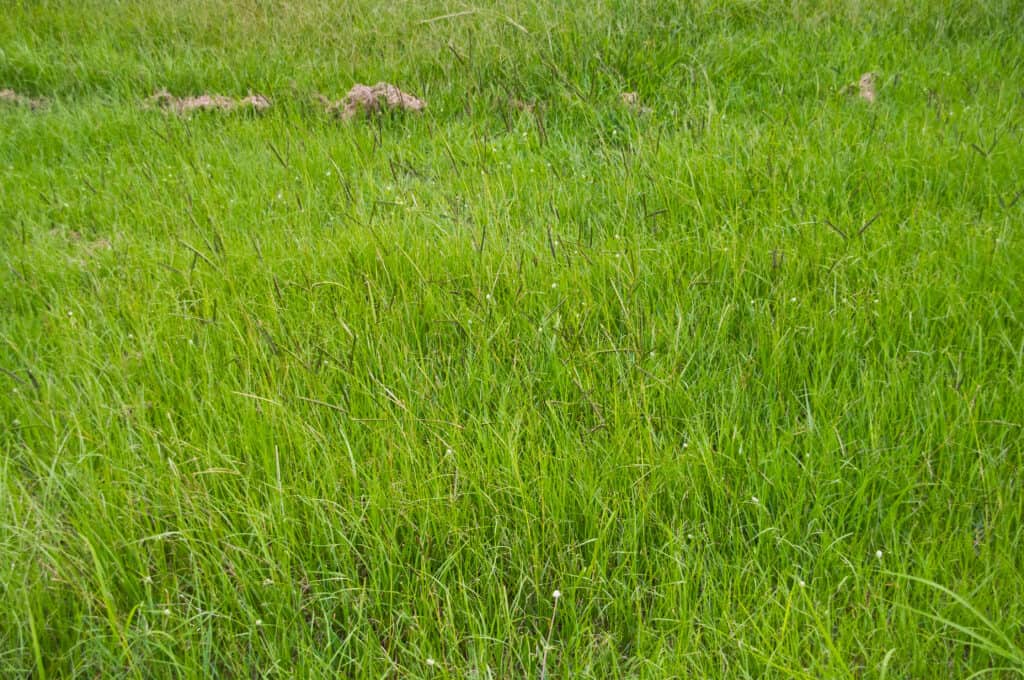Growing grass in sandy soil isn’t always an easy task. The soil conditions can make it difficult to establish some grass seed varieties. Sandy soil doesn’t retain water and nutrients easily, so you’ll want to opt for hardy, drought-tolerant grass types. Plus, sandy soil has loose particles that create air pockets, making it hard for grass roots to take hold and thrive.
However, that doesn’t mean you can’t have a lush lawn with thick, green grass. Here are some of the best grass seeds for sandy soil and critical care tips for the best results.
Best Grass Seed for Sandy Soil
Some of the top options for grass seed for sandy soil include the following:
Zoysia Grass

Zoysia grass is one of the best options for sandy soil.
©Joanne Dale/Shutterstock.com
This grass is often considered the best type for sandy soil. Zoysia grass tolerates high heat and drought and is highly resistant to foot traffic.
It also has a strong, long root structure that can take hold easier than other options. Once it takes hold, it spreads quickly, giving you a lush green lawn despite the sandy soil.
During winter, Zoysia grass turns golden brown as it goes dormant. Then, in spring or early summer, it turns green and grows again.
Tall Fescue

If you have sandy soil, tall fescue grass seed might be the way to go for your lawn.
©Sheryl Watson/Shutterstock.com
This grass is a cool-season grass that grows well in sandy soil in the northern US. Tall fescue grows slowly and doesn’t require much maintenance because it has a deep root structure that makes it resistant to drought.
Bahia Grass

Bahia grass doesn’t look as full as other types but grows well in sandy soil.
©John Robert McPherson, CC BY-SA 4.0, via Wikimedia Commons – License
As a grass type with a deep root system and heat and drought tolerance, Bahia grass is one of the best grass seeds for sandy soil. It adapts to many soil conditions and can thrive without much water. One issue with this grass type is that it won’t give you a lush, full-looking lawn like some other options do.
Bermuda Grass

Planting Bermuda grass seed can help you achieve a lush lawn.
©aimful/Shutterstock.com
Bermuda grass is one of the best options for sandy soil because it prefers less water than other types and needs well-drained soil to thrive. It takes a little longer to establish (but quickly grows once it does) to provide a dense, green lawn.
You’ll only want to plant Bermuda grass seed in full-sun areas because it won’t grow well in shady places. This grass goes dormant during winter but liven up quickly once spring arrives.
Centipede Grass

Centipede
grass is excellent for sandy soil because it doesn’t need much water.
©Sherry Barr Photography/Shutterstock.com
This grass type doesn’t require much maintenance and doesn’t need lots of water, so it’s an option for sandy soil. Its peak growing season is spring and summer, and it’s heat resistant, so it’s a great option in warm parts of the US. The only issue with centipede grass is that it has a shallow root system and doesn’t always take hold as well.
9 Critical Care Tips
1. Increase Soil Nutrient Quality
Using fertilizer and supplement treatments in your sandy soil can help grass seeds take hold and grow. Nitrogen, phosphorus, and potassium are beneficial options that help grow healthy plants and grass.
2. Add a Compost Layer
Sandy soil has large particles that create air pockets and drain water, making it hard to establish roots. Consider adding a compost layer to help the grass form a dense thatch layer. The thatch layer will help keep the grass in place on your lawn.
3. Check Salt Levels
High sodium levels in your soil can damage grass seeds and roots. Compost with peat can help minimize salt levels and help your grass thrive.
4. Mix In Organic Matter
Adding organic matter, like compost or mulch, to the top six to 10 inches of soil. It gives the soil more substance so the roots can take hold.
5. Cover the Seeds
After planting the seeds, consider covering them with a little more soil. Covering them can help ensure the seeds don’t blow away before sprouting and taking root.
6. Follow the Directions on the Package
Each seed package should have directions for upkeep and watering times. Following these directions can help you grow a lush, green lawn.
7. Plant the Seed When the Soil Is Warm
The best time to plant grass seed is typically in late summer or early autumn because the soil is warm. It’s also the best time because moderate temperatures during the day and cool temperatures at night promote germination.
8. Dethatch Yearly
Dethatching, or raking your lawn, removes dead grass layers that build up on your lawn’s surface. It promotes a healthy lawn and prepares it for applying fertilizer.
9. Change Your Mowing Pattern
Mowing your lawn in the same pattern each time can cause ruts or compaction. Instead, switch your pattern often to keep your lawn looking great.
The photo featured at the top of this post is © Joyjiraporn/Shutterstock.com
Thank you for reading! Have some feedback for us? Contact the AZ Animals editorial team.






